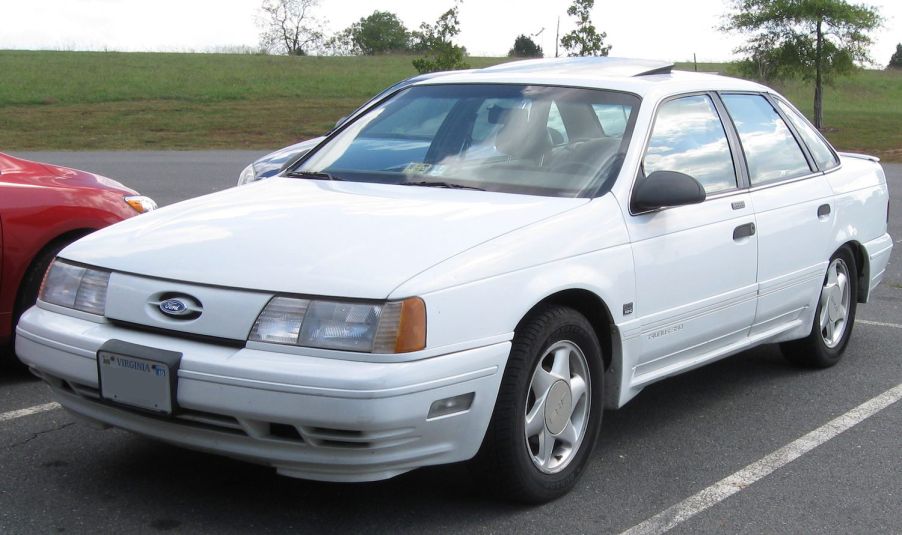
The 1986 Ford Taurus Is the Single Most Important Vehicle Design of the Past 50 Years – Convince Me I’m Wrong!
You would be forgiven for overlooking the Ford Taurus. Since the late 1980s, it has had the nearly invisible role of nondescript people mover. But when the first 1986 Ford Taurus car hit the streets in 1985, it was a revolution. Its design was so cutting-edge that Ford had to lobby the U.S. government to be allowed to build the Taurus the way they wanted. Here are the Ford Taurus’ cutting-edge features:
- Aerodynamic shape
- Composite headlights
- Ergonomic interior
- Japanese-tuned performance powertrain
Ford was forced to reinvent itself
After the 1979 oil crisis, Ford’s failure to make a lightweight FWD sedan nearly crippled the company. Between 1979 and 1982, the automaker lost $3 billion. But it had another problem. Any old FWD sedan would not be enough to take on its competitors imported from Japan. It would need something revolutionary–and high quality.

Statistician W. Edwards Deming visited Ford and concluded that management was responsible for 85% of all the problems the company was experiencing as it struggled to build better cars. So Ford clarified that management’s primary responsibility was not advertising or the bottom line but the quality of the cars rolling out of the factory.
The company even folded this new philosophy into its advertising with the 1981 slogan, “Quality is Job 1.” One of the new Ford’s most revolutionary–and successful–products was the 1986 Taurus sedan.
Ford had to battle to build the Taurus

As Ford management studied the global car market, it became clear that custom-shaped headlight housings would unlock a more rounded vehicle shape, better fuel mileage, and modern styling. The only problem was that they were illegal.
Envision your favorite car of the 1950s or 60s or 70s. Now picture one of each. Even though they had vastly different body shapes, they all had simple headlights. Either circles or rectangles, but identical to other circular or rectangular headlights.
In the 1940s, standardized sealed beam headlights were a great way to guarantee bright, waterproof lights on every car. But by the mid-1980s, automakers were well capable of engineering one-off headlights that were up to snuff. European automakers were already building headlights that were “composites” of a uniquely shaped cover, housing, and bulb. But in the U.S., sealed beams were still the law.
Ford management wanted to explore a more aerodynamic design with its Taurus, a shape that would be affectionately nicknamed the “jelly bean.” But first, it had to lobby the government to make composite headlights legal. So it did.
The first car available without sealed beams in the U.S. since 1948 was the Lincoln Continental Mark VII. Then, late in 1985, Ford released the 1986 Ford Taurus. Everyone lost their minds.
The forward-looking Ford Taurus

Modern features such as flush handles and door tops that flowed into the roofline made their mainstream debut with the Taurus. Not only was it rounded, but the car had no grille! Ford called this the “bottom breather” design, and it’s making a comeback in the electric era. Nowadays, we are used to cars that are round and aerodynamic. But imagine seeing the 1986 Ford Taurus parked in a row of brick-like 80s sedans.
The Ford Taurus’ interior is defined by its cockpit layout. First of all, every single control was within the driver’s reach. This sounds absurdly obvious. But as the owner of a Ford truck designed just before the Taurus revolution, I’m here to say it was a much-needed improvement. Secondly, every control was shaped differently or moved differently–so you could use them without taking your eyes off the road. Brilliant!
MotorTrend praised the Taurs as “the shape of tomorrow.” Popular Mechanics labeled it a “totally new breed of car.” And Hollywood was captivated by it. The first-gen Ford Taurus starred in both Back to the Future II and RoboCop as the car of the future.
Finally: a FWD Ford!

The Taurus was just as cutting-edge under the hood. With the 1986 Taurus, Ford finally joined Chrysler Corporation and General Motors in making a fuel-efficient FWD car. But it didn’t stop there.
Ford turned to SVT to engineer a “Super High Output” version of the Taurus. SVT decided to build a sedan to compete with increasingly popular Japanese sedans by turning to a Japanese automaker. It had Yamaha tune a V6 for the FWD manual sports sedan. The result made 220 horsepower, just a hair less than the V8 Mustang of the same era.
Next, meet the VW Rabbit: a compact car engineered to replace the Beetle that was available as a convertible–or a truck! Or, see the original MotorWeek review of the 1986 Ford Taurus in the video below:





